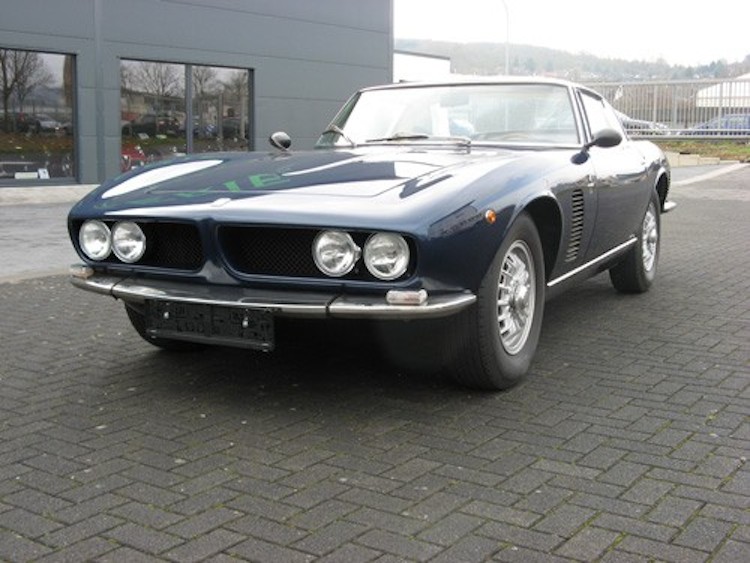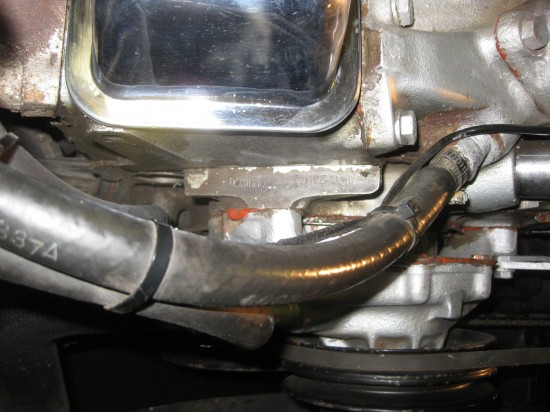by Mike –
My confidential sources have sent in more information on the Iso Grifo recently sold by Coys in Essen, Germany.
Shortly afterwards the Grifo was seized by the German authorities.
Remember that Douglas Jamieson of Coys said before the Grifo was auctioned,
There has been a lot of conjecture about the chassis number on this car, but we have verified with the owners club that it is chassis 001, the Grifo prototype, and therefore a very important and rare car.
Text and photo by anonymous sources
Coys has apparently not only made incorrect statements about the chassis of the ISO Grifo but also about the engine. A visitor who inspected the car before the auction took a picture of the engine number (see below) which leads to the following observations:
When ISO used to install a Chevrolet engine in a particular car they added their own 3-4 digit engine number to the Chevrolet-supplied engine number. These ISO numbers were preceded and followed by a star symbol. The engine number on the Grifo offered by Coys neither in structure nor font resembles that of original, factory-installed engines. Instead, the engine number of the Coys Grifo shows a standard format used by Chevrolet on all their engines after circa 1968.
This format consists of two numbers: the first number is the chassis number of the GM car that this particular engine was put into. The second number is the actual engine number. Such a system makes sure, that any engine swap can immediately be detected by a comparison of stamps on the chassis and the engine. Thus, even just the format of the engine stamping on the Coys Grifo immediately reveals that this could not possibly be the original engine.
The Chevrolet engine stamping can be decoded and reveals when and where the engine was built and what kind of a car it was put into. It is important to know, that ISO purchased Chevrolet engines which were built to Corvette specifications. We will use the following guide to decoding Chevrolet engines (there are others, they do not differ except in level of detail).
Following this guide it becomes evident that the engine in the Coys 1966 Grifo has been swapped for a 1974 engine which is not to Corvette specification.
Chassis number of the original car in which the engine was installed: 14N1117?6
1=Chevrolet
4=1974
N=Norwood = assembly plant of the car
1117?6 = production sequence of vehicle VINAt this point it is already clear, that this cannot possibly be the original engine. The car was built six years after the Coys ISO Grifo. C2 Corvettes were exclusively built in Flynt, MI and St. Louis, MO – certainly not in Norwood. This engine has been taken from another car, not a Corvette.
Engine number: T0820CMA
T=Tonawanda=production plant of engine
08=August
20=day twenty
CMA=350 cubic inch displacement, tur hydro trans (automatic transmission), 2bbl carburetor, used in Chevy platforms A B F X (Chevelle, Camaro, Nova, as well as various 4-door Chevrolet, Oldsmobile and Pontiac cars).So this engine was built on August 20, 1974 and used in a car with automatic transmission which was not a Corvette. ISO closed its doors in 1974. In other words, nothing about this engine is original with respect to an ISO Grifo.
The Coys auction catalog description states specifically,
The car is presented in original condition and it still retains its original Chevrolet V 8 engine mated to a 4-speed gearbox.
With respect to other, minor pieces of information, Coys specifically states that they rely on information provided by the seller. Not so in the case of the originality of the engine. Thus the reader of the catalog description must assume that Coys itself stands behind the claim that this car retains its original engine.
However, the above analysis shows, that even a casual but experienced look at the engine numbers would have been sufficient to realize, that this could not possibly be the original engine. Shouldn’t a reputable auction house for classic cars have realized this much immediately? And would they not have found it necessary to make these important facts known through their catalog description for all potential buyers to know?
Would such crucial information not have had a significant impact on the value of the car, particularly if this car was “the prototype”? Should not an auction house selling a particularly significant car (like a prototype) be held to a higher than usual standard when it comes to both, the verification of the object in question and the representation of the object in the catalog description?
It will be up to the German authorities to decide what happened here and what they will do about it.
It does not look good for Coys or for the seller of this Grifo. I hope the buyer had not yet paid for this Grifo before it was seized but I do not know. The buyer could have done a little home work and discovered this was not a correct Iso Grifo chassis number, the engine was not the original engine and this Grifo could not possibly be the Grifo #001 prototype.
With the chassis number in question the ownership trail is suspect with possibilities like theft or the use of this cars chassis number and paper work for another Grifo. No matter what happened it is not good for any new owner of this Grifo until this is all cleared up and the correct chassis number is returned to this car. Until then I suspect this Grifo will be in a police garage for a while.
Let us know what you think in the Comments.
Support My Car Quest – Click Here




Mike,
I love the way you just tell it like it is.
But at least Coys didn’t prattle on about the original rust and dust and patina…..
From the dates in question, and the Norwood assembly plant, it’s most likely that as pointed out, this engine was not from a Corvette, rather it probably came from a Camaro. Thanks to Mike diligence, he’s pointed out this car for what it is, a fake.
I suspect that this is going to be a permanent stain on the reputation of Coys, especially given that they were alerted, from multiple parties, that this car was suspect and should have been withdrawn from the auction.
Richard the car is not a fake it’s a real Grifo, it’s the Grifo’s VIN number that is in question.
Fascinating saga of obvious fraud. Just one minor correction, not really related to the story. C2 Corvettes were only assembled in St. Louis, Missouri, and not in Flint, Michigan. The first year of production of 300 1953 C1 Corvettes were all hand-assembled in Flint, Michigan, and then all subsequent mass production was moved to St. Louis. St. Louis kept cranking out Corvettes until the C4 production began in 1984, where all subsequent production to present is done in Bowling Green, Kentucky. Glenn in the Bronx, NY.
Regarding the details of the sale of an Iso Griffo which was described in its documentation and paperwork as being chassis 001, Coys confirm that despite incorrect comments being circulated by parties who were not in attendance at the event, the transaction for this car has not taken place and the matter of the car is now being handled in Germany where the event took place.
The case of historic motorcars due to the nature of their age where some confusion arises about their history is commonplace throughout the world and in this particular instance upon the acknowledgement of claims being made of an alternative car with the same chassis number the matter was handled in an entirely appropriate manner and the sale has not proceeded.
This situation, although unfortunate, is simply no more complicated than that.
C.Routledge
COYS
Yet even though Coys was contacted by multiple parties prior to the auction about the cars incorrect VIN number they allowed the car to be auctioned and hammered through……… as simple as THAT.